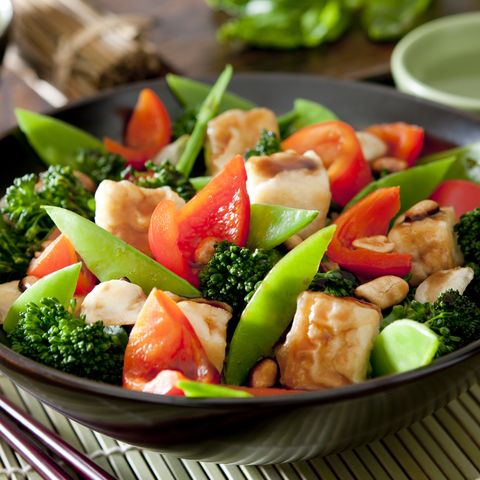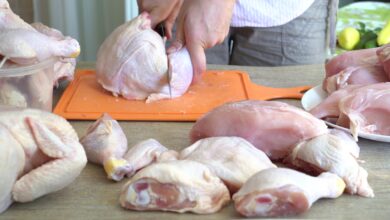What Is the Flexitarian Diet?

Flexibility is an important skill for getting along in today’s ever-changing world — and it may also be the key to maintaining a healthy, sustainable, earth-friendly diet. A recent survey found that while only 3% of American consumers consider themselves vegan and 5% vegetarian, a full 36% proudly identify as “flexitarian.” The plant-leaning lifestyle seems to have hit a sweet spot for those who are intrigued by the benefits of going vegetarian (it’s better for the planet, better for your health, and, of course, kinder to the animals), but feel that saying goodbye forever to Grandma’s meatballs or their favorite Thai restaurant’s chicken satay is too much of a sacrifice.
And unlike other, more restrictive eating plays, the Flexitarian diet leaves room for customization so it can fit into any lifestyle. Intrigued? Here’s what you need to know to get started.
What is the Flexitarian diet?
The diet emphasizes plant-based foods most of the time, but also leaves wiggle room for the occasional meaty indulgence. “This was inspired by my personal situation,” explains Flexitarian nutritionist Dawn Jackson Blatner, R.D. “As someone who has studied different ways people eat in the world, I know that eating a plant-based diet lowers your risk of diabetes, heart disease and cancer, and I was like, ‘Um, hi, I want that!‘” But Blatner still found herself grabbing a hot dog at a baseball game and eating turkey on Thanksgiving, making her feel like a “bad” vegetarian. “And then I thought, ‘this isn’t a bad way of being a vegetarian, it’s a flexible way of being a vegetarian. It’s vegetarian-ish,’” she says with a laugh.
Blatner put together the words flexible and vegetarian, and created the mostly (but not entirely) plant-based plan, which she outlined in her 2009 book, The Flexitarian Diet: The Mostly Vegetarian Way to Lose Weight, Be Healthier, Prevent Disease, and Add Years to Your Life The diet focuses on foods such as beans, nuts, whole grains, and produce, but, as she says, “it’s not anti-meat.”
How often do flexitarians eat meat?
Depending on your commitment, there is room for up to 28 ounces of lean meat or poultry per week — though as you add more delicious vegetarian meals to your roster, you may drop down to just 3 ounces of meat up to three times a week. For weight loss, Blatner recommends you stick to a Flexitarian diet that provides around 1,500 calories per day.
Is the flexitarian diet healthy?
In the decade since Blatner first introduced the Flexitarian diet, it has taken on a life of its on, with the word “flexitarian” even being added to the venerable Oxford English Dictionary in 2014. It has also consistently ranked near the top of U.S. News & World Report’s best overall diets. Not only is the flexible and forgiving plan easy to follow, but it brings real results: A 2017 review found that people who follow a semi-vegetarian diet had lower body weight than those who regularly ate meat, as well as lower incidence of metabolic disease and lowered risk for type-II diabetes.
If you’re interested in giving the diet a try, here’s how to get started:
Choose your level:
If you’re a big-time meat eater and simply want to cut down, it’s easy to ease into the Flexitarian diet, says Blatner. “I recommend three different levels of the diet: Beginner, Advanced, and Expert,” she says.
Beginner: “There are 21 meals a week — you can start by having just 7 meatless meals a week.” That simply means if you need to have bacon or ham with your breakfast, make your lunch or dinner meat-free that day.
Advanced: Aim for up to 14 meatless meals a week, which means you still get to eat your burger or turkey sandwich once a day.
Expert: At this level, you’re only eating meat 6 or less times per week — or going entirely meatless for weeks, only indulging on special occasions. Blatner suggests you save these for “meaningful meat moments” — a family barbecue where everyone is enjoying burgers together, a holiday meal centered around a turkey or goose, a special dinner out at your partner’s favorite steakhouse. “Another big meat moment is travel,” says Blatner. “There’s no better way to experience a different culture then to taste their food, and this diet gives you room to enjoy it.”
This content is imported from {embed-name}. You may be able to find the same content in another format, or you may be able to find more information, at their web site.
Learn to re-portion your plate:
When you do eat meat, consider it a side dish instead of the main, says Blatner. “Instead of having a ginormous piece of meat as the center of the plate — which is the traditional American style — it should just be a quarter of the plate, with another quarter filled with whole grains, and then the remaining 50% vegetables.”
Reinvent old favorites:
There are a few kinds of meat that just can’t be realistically replaced with plants (hello, T-bone steak). But a surprising number of meat-based dishes can be given an easy veggie makeover, says Blatner. “If you love tacos, how about doing bean tacos? If you enjoy a chicken stir-fry, you can replace the chicken with edamame or tofu,” she says, adding that for every 1 ounce of meat, you can swap in ¼ cup of beans. Blatner adds that although plant-based burgers such as Beyond and Impossible have the mouth feel and juiciness of a beef burger, she prefers to swap them out for burgers made with beans, which are lower in saturated fat and calories than the faux-meat ones.
Refresh your recipe list:
Emphasizing that the Flexitarian diet is more about adding delicious new foods to your life than taking things away, Blatner is most enthusiastic about this step: “This is where you’re actually trying new recipes, and it’s where I feel people get some real eye-opening in their lives,” she says. She suggests you try out one new vegetarian recipe each week. You can look them up on blogs, web sites, magazines, cookbooks, and right here. “Not every recipe is going to be a keeper, but if you try 50 new ones in a year, and you love 10 of them, that’s going to make it so much easier to cook vegetarian going forward.”
Here are Blatner’s suggestions for your first three days of meals, with options for both meat and veggies:
DAY 1
Breakfast:
Avocado Toast: sprouted whole grain toast, avocado, spinach, and egg
Lunch:
Kale Ranch Bowl: chicken or chickpeas, chopped kale/tomatoes, roasted sweet potato cubes, and ranch dressing
Dinner:
Tacos: seasoned white fish or lentils, corn tortillas, cabbage slaw, guacamole, and salsa
DAY 2
Breakfast:
Peanut Butter Oatmeal: oatmeal, natural peanut butter, and chopped apple
Lunch:
Mexican Bowl: chicken or black beans, chopped romaine/peppers, brown rice, guacamole, and salsa
Dinner:
Mediterranean Plate: chicken or chickpeas, cucumber/tomato/feta salad, and lemon-dill brown rice
DAY 3
Breakfast:
Green Belly Smoothie: 2% plain kefir, rolled oats, banana, and spinach
Lunch:
Asian Bowl: chicken or edamame, coleslaw mix, quinoa, and ginger dressing
Dinner:
Burger Night: beef or bean burger, sweet potato fries, and veggie dippers w/ ranch
This content is created and maintained by a third party, and imported onto this page to help users provide their email addresses. You may be able to find more information about this and similar content at piano.io
Source link






